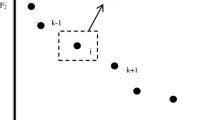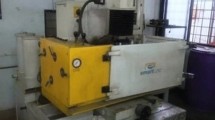Abstract
Powder mixed electro-discharge machining (EDM) is being widely used in modern metal working industry for producing complex cavities in dies and moulds which are otherwise difficult to create by conventional machining route. It has been experimentally demonstrated that the presence of suspended particle in dielectric fluid significantly increases the surface finish and machining efficiency of EDM process. Concentration of powder (silicon) in the dielectric fluid, pulse on time, duty cycle, and peak current are taken as independent variables on which the machining performance was analysed in terms of material removal rate (MRR) and surface roughness (SR). Experiments have been conducted on an EZNC fuzzy logic Die Sinking EDM machine manufactured by Electronica Machine Tools Ltd. India. A copper electrode having diameter of 25 mm is used to cut EN 31 steel for one hour in each trial. Response surface methodology (RSM) is adopted to study the effect of independent variables on responses and develop predictive models. It is desired to obtain optimal parameter setting that aims at decreasing surface roughness along with larger material removal rate. Since the responses are conflicting in nature, it is difficult to obtain a single combination of cutting parameters satisfying both the objectives in any one solution. Therefore, it is essential to explore the optimization landscape to generate the set of dominant solutions. Non-sorted genetic algorithm (NSGA) has been adopted to optimize the responses such that a set of mutually dominant solutions are found over a wide range of machining parameters.
Similar content being viewed by others

References
Abbas N M, Solomon D G and Bahari M F 2007 A review on current research trends in EDM. Int. J. Machine Tools Manufact. 47(7–8): 1214–1228
Benedict G F 1987 Non-traditional manufacturing process. New York: Marcel Dekker
Chow H M, Yan B H, Huang F Y and Hung J C 2000 Study of added powder in kerosene for the micro-slit machining of titanium alloy using electro-discharge machining. J. Mater. Processing Technol. 101(1–3): 95–103
Deb K, Pratap A, Agarwal S and Meyarivan T 2002 A fast and elitist multiobjective genetic algorithm: NSGA-II. IEEE Trans Evol Comput 6(2): 182–197
Fenggou C and Dayong Y 2004 The study of high efficiency and intelligent optimization system in EDM sinking process. J. Mater. Processing Technol. 149(1–3): 83–87
Furutani K, Saneto A, Takezawa H, Mohri N and Miyake H 2001 Accertation of titanium carbide by electrical discharge machining with powder suspended in working fluid. Precision Eng. 25(2): 138–144
Gao Q, Zhang Q H, Su S P and Zhang J H 2008 Parameter optimization model in electrical discharge machining process. J. Zhejiang University Science A 9(1): 104–108
Jeswani M L 1981 Effects of the addition of graphite powder to kerosene used as the dielectric fluid in electrical discharge machining. Wear 70(2): 133–139
Joshi S N and Pande S S 2011 Intelligent process modeling and optimization of die-sinking electric discharge machining. Applied Soft Computing 11(2): 2743–2755
Kanagarajan D, Karthikeyan R, Palanikumar K and Davim J P 2008 Optimization of electrical discharge machining characteristics of WC/Co composites using non-dominated sorting genetic algorithm (NSGA-II). Int. J. Advanced Technol. 36(11–12): 1124–1132
Kansal H K, Singh S and Kumar P 2005 Parametric optimization of powder mixed EDM by response surface methodology. J. Mater. Processing Technol. 169(3): 427–436
Keskin Y, Kalkaci H S and Kizil M 2006 An experimental study for determination of effects of machining parameters on surface roughness in EDM. Int. J. Advanced Technol. 28(11–12): 1118–1121
Kuriakose S and Shunmugam M S 2005 Multi-objective optimization of wire electro discharge machining process by non-dominated sorting genetic algorithm. J. Mater. Processing Technol. 170(1–2): 133–141
Lin J L and Lin C L 2005 The use of grey-fuzzy logic for the optimization of the manufacturing process. J. Mater. Processing Technol. 160(1): 9–14
Lin Y C, Yan B H and Huang F Y 2001a Surface improvement using a combination of electrical discharge machining with ball burnish machining based on the Taguchi method. Int. J. Advanced Manufact. Technol. 18(9): 673–682
Lin Y C, Yan B H and Huang F Y 2001b Surface modification of Al-Zn-Mg aluminum alloy using the combined process of EDM with USM. J. Mater. Processing Technol. 115(3): 359–366
Mandal D, Pal S K and Saha P 2007 Modeling of EDM process using BP neural network and multi-objective optimization using non-dominating sorting GA. J. Mater. Processing Technol. 186(1–3): 154–162
Ming Q Y and He L Y 1995 Powder suspension dielectric fluid for EDM. J. Mater. Processing Technol. 52(1–3): 44–54
Mohri N, Saito N and Higashi M A 1991 A new process of finish machining on free surface by EDM methods. Annals of CIRP 40(1): 207–210
Montgomery D C 1997 Design and analysis of experiments. Fourth edition, New York: John Wiley Sons
Nixon K and Ravindra H V 2011 Parametric influence and optimization of wire EDM of hot die steel. Machining Science and Technol. 15(1): 47–75
Panda D K and Bhoi R J 2005 Artificial neural network prediction of material removal rate in EDM. Mater. Manuf. Process. 20(4): 645–672
Pecas P and Henriques E 2003 Influence of silicon powder-mixed dielectric on conventional electrical discharge machining. Int. J. Machine Tools Manufact. 43(14): 1465–1471
Pecas P and Henriques E 2008 Effect of the powder concentration and dielectric flow in the surface morphology in electrical discharge machining with powder mixed dielectric. Int. J. Advanced Manufact. Technol. 37(11–12): 1120–1132
Rao G K M., Janardhana G R, Rao D H and Rao M S 2008 Development of hybrid model and optimization of surface roughness in electric discharge machining using artificial neural networks and genetic algorithm. ARPN J. Eng. Appl. Sci. 3(1): 1512–1520
Schumacher B M 1990 About the role of debris in the gap during electrical discharge machining. Annals of CIRP 39(1): 197–199
Sen M and Shan H S 2007 Electro jet drilling using hybrid NNGA approach. Robot. Comput. Integrated Manuf. 23(1): 17–24
Singh S, Kansal H K and Kumar P 2005 Parametric optimization of powder mixed electrical discharge machining by response surface methodology. J. Mater. Processing Technol. 169(3): 427–436
Somashekhar K P, Ramachandran N and Jose M 2010 Optimization of material removal rate in micro-edm using artificial neural network and genetic algorithms. Mater. Manufact. Processes 25(6): 467–475
Su J C, Kao J Y and Tarng Y S 2004 Optimization of the electrical discharge machining process using a GA based neural networks. Int. J. Advanced Manufact. Technol. 24(2): 81–90
Tzeng F Y and Chen Fu 2003 A simple approach for robust design of high speed electrical-discharge machining technology. Int. J. Machine Tools Manufact. 43(3): 217–227
Tzeng Y and Chen F 2007 Multi-objective optimization of high speed electric discharge machining process using a Taguchi fuzzy-based approach. Mater. Des. 28(4): 1159–1168
Wang K, Gelgele H L, Wang Y, Yuan Q and Fang M 2003 A hybrid intelligent method for modeling the EDM process. Int. J. Machine Tools Manufact. 43(10): 995–999
Wong Y S, Lim L C and Lee L C 1995 Effect of flushing on electro-discharge machined surfaces. J. Mater. Processing Technol. 48(1–3): 299–305
Wong Y S, Lim L C, Rahuman I and Tee W M 1998 Near-mirror-finish phenomenon in EDM using powder-mixed dielectric. Int. J. Advanced Manufact. Technol. 79(1–3): 30–40
Yu Z, Jun T and Masanori K 2004 Dry electrical discharge machining of cemented carbide. J. Mater. Processing Technol. 149(1–3): 353–357
Yang S H, Srinivas J, Mohana S, Lee D K and Balaji S 2009 Optimization of electric discharge machining using simulated annealing. J. Mater. Processing Technol. 209(9): 4471–4475
Yuan J, Wang K, Yu T and Fang M 2008 Reliable multi-objective optimization of high-speed WEDM process based on Gaussian process regression. Int. J. Machine Tools Manufact. 48(1): 47–60
Zhang L, Jia Z, Wang F and Liu W 2010 A hybrid model using supporting vector machine and multi-objective genetic algorithm for processing parameters optimization in micro-EDM. Int. J. Advanced Manufact. Technol. 51(5–8): 575–586
Zhao W S, Meng Q G and Wang Z L 2002 The application of research of powder mixed EDM in rough machining. J. Mater. Processing Technol. 129(1–3): 30–33
Author information
Authors and Affiliations
Corresponding author
Rights and permissions
About this article
Cite this article
PADHEE, S., NAYAK, N., PANDA, S.K. et al. Multi-objective parametric optimization of powder mixed electro-discharge machining using response surface methodology and non-dominated sorting genetic algorithm. Sadhana 37, 223–240 (2012). https://doi.org/10.1007/s12046-012-0078-0
Received:
Revised:
Accepted:
Published:
Issue Date:
DOI: https://doi.org/10.1007/s12046-012-0078-0



